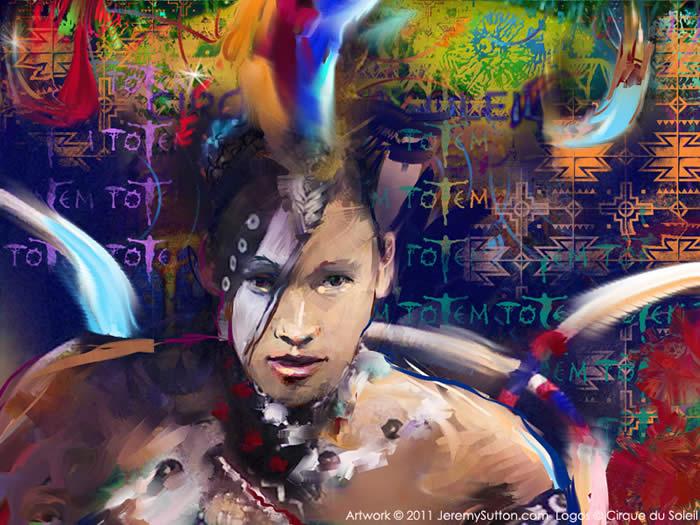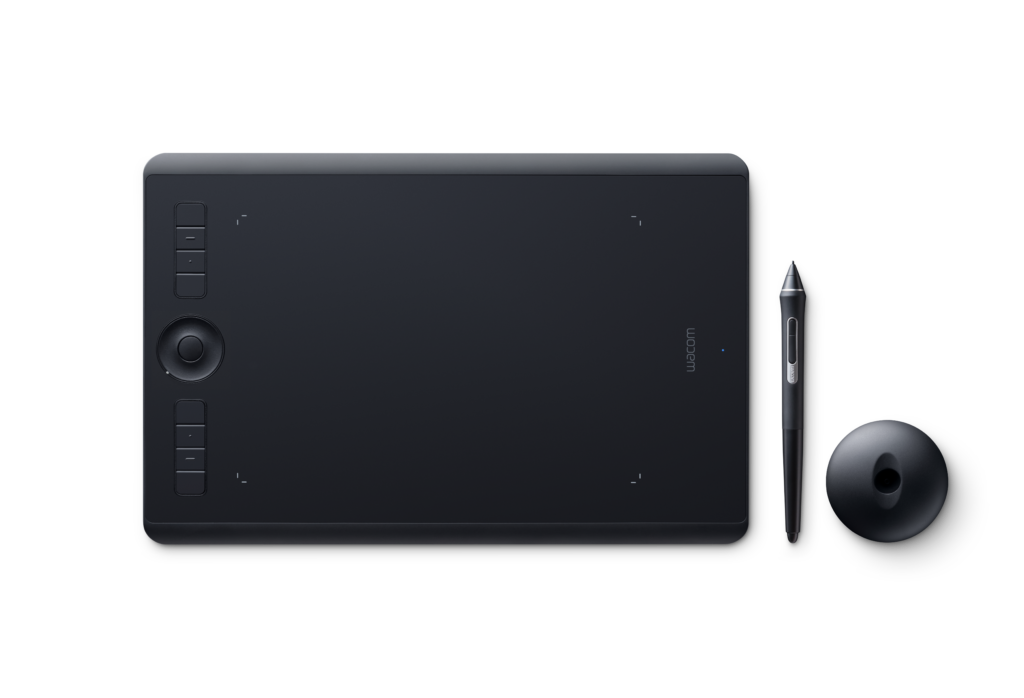

Photo credit: Shalom Gibly
Wacom had a chance to talk with digital painting pioneer, Jeremy Sutton, about the tech he uses to create his masterpieces. Sutton has found himself painting luminaries such as Richard Branson and performers from renowned groups such as Cirque du Soleil with his Intuos Pro. We asked Sutton about the tools he uses for his digital painting.
Wacom: A Wacom pen tablet, specifically the Intuos Pro, has been instrumental to your digital painting career. What were your first impressions of working with a Wacom tablet and how does the Intuos Pro still motivate you today?
JS: From the very first moment I picked up a Wacom pen and started drawing with it on the tablet surface, back in 1991, it felt natural. It flowed smoothly and was surprisingly precise in its resolution and highly sensitive to pressure, even light pressure. My first impression was “wow! this is fun!!” It came very easily to me and felt very similar to the feel I was used to in using pastel crayons on paper. The pressure sensitivity was essential – it enabled me to forget that I was working in a digital world and instead just draw like I normally would. Today my Wacom Intuos Pro is an indispensable part of my computer set up whether working in my studio on my iMac, or traveling the world with my MacBook Air. I love the medium sized Wacom Intuos Pro since provides the perfect balance of convenience, ease-of-use and portability without being too small. In other words it’s very comfortable. Comfort is, for me, a key ingredient for digital creativity. When I am comfortable I can paint for hours without any adverse physical fatigue or stress, and I can also forget the digital and be focused and immersed in the zone of making art. What more motivation can you have than well designed and effective tools, like the Wacom Intuos Pro, that empower your creativity and are fun to use!
Wacom: Would you like to share with our readers some of your most recognized commissioned pieces that were done on an Intuos Pro?
JS: Large Heart on Union Square, San Francisco, and now in the permanent collection of Visa Corporation.
Digital artworks created live in the Tapis Rouge tent of the Cirque du Soleil Totem show, San Francisco.
Silicon Valley History Series of large digital paintings output onto metal and on permanent display at the San Jose Marriott


Wacom: You’ve been a great digital art teacher for many decades. How do you incorporate Wacom tablets in your teaching?
JS: Whenever I teach Corel Painter, Wacom tablets are an integral part of my teaching and every student uses one. For instance next year in February in the computer classroom at FOTOfusion at the Palm Beach Photographic Centre, West Palm Beach, FL, every computer will be equipped with the latest Wacom Intuos Pro pen tablet and later in the year in June at the East Coast School in Raleigh, NC, every student will bring their own Wacom tablet.
Wacom: Your relationship with Corel Painter is well-known. Did they discover you or did you discover them?
JS: My relationship with the team behind Painter started at the MacWorld Be-In in January 1992 when I met John Derry and Steve Manousos demonstrating the first version of Fractal Design Painter. I started using Painter and then ended up demonstrating it for Fractal Design at trade shows throughout the world, traveling as far a field as MacWorld Tokyo on a couple of occasions. I got to know Painter’s original co-creators Mark Zimmer and Tom Hedges as well as the whole Fractal Design team, attending their annual picnics and events. The Painter community in those early days had a very close, friendly, family feel with industry partners, artists such as myself and other demo artists like Cher Thrienen-Pendarvis and Chelsea Sammel, customers and technologists all mingling.
So in answer to the question “Did they discover you or did you discover them?” the answer is a bit of both: I first discovered them and then they discovered me!
Wacom: Is there a particular moment or series of moments that inspired you to be an artist?
JS: In looking back I would lean towards the “series of moments” option versus “a particular moment” in identifying what inspired me to become an artist. As a child I was encouraged to make art at home – my parents said I could draw all over my bedroom wall as long as I left the rest of the house alone – and at school – one primary school teacher in particular, Miss Tipler, encouraged me at every opportunity. I went to Saturday morning art classes, visited the great art museums of London, and attended art lectures and outings. Later on I would spend time with different artists learning printmaking and sculpture. All this added up to loving art, doing a lot of drawing and feeling that art was important. I think that these early influences – many many moments over many formative years – are what inspired and motivated me to ultimately pursue art at a professional level, or, as the question puts it, “be an artist”.
Wacom: You are a pioneer of sorts in digital media, dating back to 1991. How did this all get started for you?
JS: Years ago, by fortuitous coincidence, I found myself living in the heart of Silicon Valley at the very period of time when four crucial technological components came together, also centered around Silicon Valley:
- Powerful Macintosh computers (the IIfx in particular),
- High resolution 8-bit color monitors offering millions of colors,
- Pressure-sensitive Wacom pen tablets with Macintosh drivers, and,
- Paint programs like PixelPaint Pro that took full advantage of the other three advances.
From the moment I first painted on the Mac with a Wacom tablet and PixelPaint Pro software I was hooked on digital paint and embarked on a mission to explore and experiment with technology, tools and devices for painting (and printing). That included experimenting with every paint program I came across, from Time Arts Oasis and ArtMixer to Fractal Design Painter. In the end Painter rose to the top of the bunch to be the predominant surviving paint program, and that was the program I started teaching, writing books on (including the “Painter Creativity: Digital Artists’ Handbook“ series) and presenting at conferences (such as SIGGRAPH, MacWorld, Imaging USA, etc). From the get go, my relationship with digital media has been closely associated with close relationships with the vendors who design, make, produce and market the media, tools and devices, Wacom being the first and foremost and most enduring to this day, twenty eight years later!
Wacom: What’s next for Jeremy Sutton?
JS: I am currently enjoying digital art explorations in many directions, from iPad painting and using Augmented Reality (AR) to extend my digital prints, to painting in 3D in Virtual Reality (VR) using Google Tilt Brush and the Oculus Rift. I’ve previously explored eye tracking and gesture control (Leap Motion) inputs for digital painting and am always open to new technologies and media. I love the excitement and creativity of live event painting, and look forward to continuing doing much more of that!
On the teaching front I will continue to have a mix of in-person classes and workshops plus will continue developing my online teaching resource PaintboxTV.com with its video tutorials and monthly interactive webinar sessions.
However the one constant that I know the future holds is that whatever technology, media and tools I explore, I will always come back to my solid, reliable Wacom Intuos Pro tablet when I am back in my studio or being productive on the road!
Thank you, Wacom!




